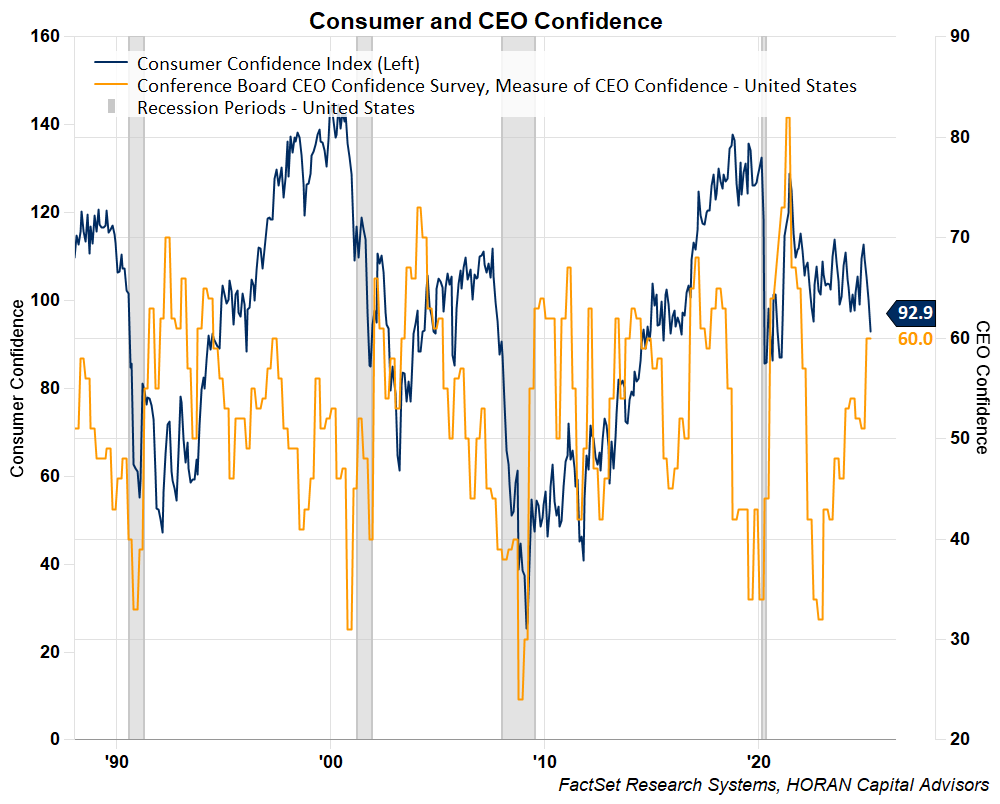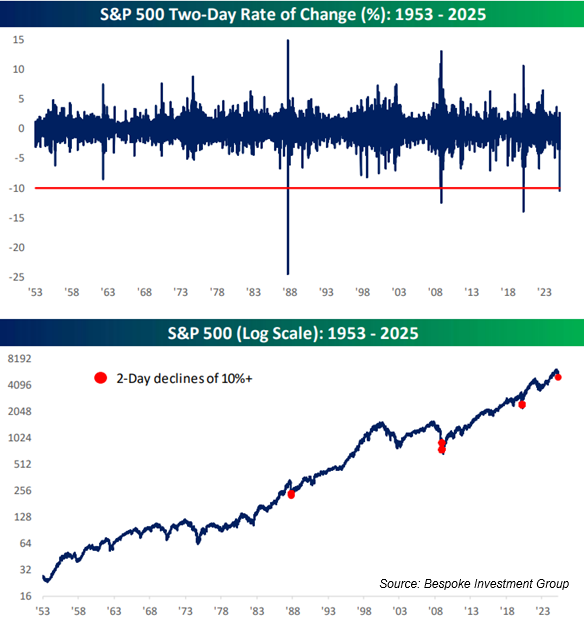Author: David I. Templeton, CFA, Principal and Portfolio Manager
The tariff announcement made by President Trump on April 2nd surprised many investors leaving many wondering what the end game looks like. Two things that lead to higher equity market volatility are uncertainty and surprises.
The size of the tariffs announced Thursday affecting some 150 countries surprised most investors and led to an S&P 500 decline of -4.84% on Thursday. Further, the calculation of the reciprocal tariff rate applied to respective countries seems focused on trade imbalances versus tariff imbalances. In the weeks leading up to the tariff announcement, the market contended with the uncertainty around the size of reciprocal tariff. Although the tariff size is now known, the amounts were larger than the market was anticipating resulting in uncertainty around the impact to the U.S. economy as well as the global economy given the unexpected size of the tariffs.
This uncertainty has led investors to question what the impact on inflation, global trade and economic activity will be. Tariffs in and of themselves do not lead to long-term sustained inflation. A one-time price increase may occur due to higher input costs for manufactures and higher product costs for retailers. However, inflation is mostly caused by an increase in the money supply and/or a government deficit spending. In the end, if the money supply and deficit spending are not increased, inflation should not run at an increasing rate in the future.

With respect to whether the economy falls into a recession; this is unknown or an uncertain outcome too. No one variable leads to a recession, but excess demand and overproduction can be a contributor. At this point in time this does not appear to be occurring. Reduced confidence at both the consumer and business level can also contribute to the economy slowing and falling into a recession. A decline in confidence is evident based on recent surveys, but the hard economic data is not supporting the weaker confidence level at this point in time. If consumers are reluctant to spend and businesses pull back on capital expenditures or expansion plans because of the uncertainty surrounding tariffs, this could tilt the economy in the direction of a recession as economic activity slows.

What is an investor to do? I am reminded of a comment in an article by the late Alan Steel of Alan Steel Asset Management where he wrote,
“But before you start reaching for the panic button, spare a thought for researcher and author Philip Tetlock, who studied the aggregate accuracy of 284 experts making 28,000 forecasts and found you’d be better off tossing a coin than tuning in.”
Looking back at President Trump’s first term in office, tariffs were a part of his strategy. During the tariff negotiations with other countries in his first term, the S&P 500 did experience an elevated level of volatility. We wrote about this in our Winter 2018 Investor Letter where we noted one item contributing to the higher volatility was “ongoing trade negotiations and tariffs.” In the fourth quarter of 2018 the S&P 500 Index was down -13.5% and since January 2, 2019, the S&P 500 Index is up a cumulative 134%. Most of the tariffs announced then turned into quotas for other countries. It does seem President Trump’s recent tariff announcement is more concerned with the trade imbalance as well; thus, quotas could be a part of the end game strategy. Certainly though, it seems clear that President Trump wants more manufacturing to move onto U.S. soil. In the long run, this should be a positive for the economy.
The S&P 500 Index did begin the week by moving higher in the first three trading days. The positive return was rapidly reversed Thursday and Friday after President Trump's tariff announcement after the market close on Wednesday. Thursday and Friday saw the S&P 500 Index down a combined -10.81%. The magnitude of this decline over a two-day period has occurred four other times since 1953 and the red dots in the below chart note those points in time.

As it goes with the stock market there are no certainties and this week is an example. However, the above chart does show these type of market events tend to not be prolonged. On the other hand, when a rapid decline occurs, a V-shaped recovery generally materializes once the event that caused the decline is resolved. In President Trump's first term, similar tariff issues impacted the market and the resolution unfolded over a multi-month time frame.
HORAN Wealth, LLC is an SEC registered investment advisor. The information herein has been obtained from sources believed to be reliable, but we cannot assure its accuracy or completeness. Neither the information nor any opinion expressed constitutes a solicitation for the purchase or sale of any security. Any reference to past performance is not to be implied or construed as a guarantee of future results. Market conditions can vary widely over time and there is always the potential of losing money when investing in securities. HORAN Wealth and its affiliates do not provide tax, legal or accounting advice. This material has been prepared for informational purposes only, and is not intended to provide, and should not be relied on for tax, legal or accounting advice. You should consult your own tax, legal and accounting advisors before engaging in any transaction. For further information about HORAN Wealth, LLC, please see our Client Relationship Summary at adviserinfo.sec.gov/firm/summary/333974.

